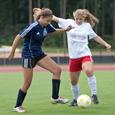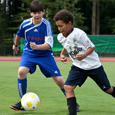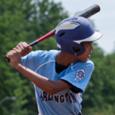Can We Change the Culture of Youth Sports?

There’s nothing that feels worse for young athletes than getting hurt and having to sit on the sidelines while their team goes on to victory. That’s why Safe Kids and Johnson & Johnson released a new report, “Changing the Culture of Youth Sports,” to explore how the culture of youth sports may be keeping kids out of the game.
But teens like Brie teach athletes that staying out of the game after a serious injury can help make sure injuries don’t get worse and athletes go on to enjoy a lifetime of playing the sports they love.
Brie’s Story
“I wish I knew then, what I know now. A game wasn’t worth risking my life.”
Last year, Brie was knocked unconscious during a high school field hockey game. She was diving to prevent a shot on goal when she got hit in the head with a hockey stick and blacked out. After a few minutes on the sideline, she went back onto the field. “There was no reason to go back into the game after a head injury like that,” says Brie.
A week later, Brie forgot how to spell her name. She suffered a severe concussion that is still dominating her life. The side effects of her traumatic brain injury are enormous. She can’t tolerate bright lights or loud sounds, is unable to focus, and can’t enjoy normal teen activities, like movies, sleepovers or driving.
A former star athlete with a bright future in college sports, Brie was recently told by doctors that she can never play contact sports again because of her concussion. Read more about Brie’s story.
New Research
With athletes heading back onto the field or into the gym for fall sports, we’ve teamed up with Johnson & Johnson to release new research about the culture of youth sports.
Did you know that every day, 3,400 kids go to ER for a sports-related injury? We spoke with more than 3,000 teens, parents and coaches to learn how kids are getting injured and what behaviors lead to serious injuries.
Here’s what we found: an alarming number of athletes are hiding injuries to stay in the game, athletes are getting injured as a result of dirty play, and parents are pressuring coaches to play injured athletes. Read more in our research report.
Infographic
One in four young athletes reported it is normal to commit hard fouls and play rough to send a message during a game. Click on our infographic to learn more.
Video
Our very own, Gary Karton, took to the streets of the National Mall in Washington, DC to ask people about their greatest sports memory as a kid. Watch the video to hear their stories.
Strategies for Smart Play
Here are some strategies for teens, parents and coaches to help keep young athletes playing safe and strong:
- Set the ground rules at the beginning of the season. Coaches bring together parents and athletes before the season begins to agree on the team’s approach to prevent injuries.
- Teach athletes ways to prevent injuries. Proper technique, strength training, warm-up exercises and stretching can go a long way to preventing injuries.
- Prevent overuse injuries. Encourage athletes to take time off from playing only one sport to prevent overuse injuries and give them an opportunity to get stronger and develop skills learned in another sport.
- Encourage athletes to speak up when they’re injured. Remove injured athletes from play.
- Put an end to dirty play and rule-breaking. Call fouls that could cause injuries.
- Get certified. Learn first aid, CPR, AED use and injury prevention skills.
Sports Quiz
How much do you know about sports safety? Take our interactive quiz to find out.
More Tips
- Want more tips to help prevent injuries on the field? Here are some top sports tips:
- Before playing organized sports, make sure your athlete receives a pre-participation physical exam, or PPE, by a doctor. This can help rule out any potential medical conditions that may place your young athlete at risk.
- Bring a water bottle to practice and games. Encourage kids to stay well hydrated by drinking plenty of water before, during and after play.
- Proper warm ups followed by stretching before practice and games can release muscle tension and help prevent sports-related injuries, such as muscle tears or sprains. Make sure there is time set aside before every practice and game for athletes to warm up properly.
- Take time off from one sport to prevent overuse injuries. It is an opportunity to get stronger and develop skills learned in another sport.
- It’s also a good idea for coaches to get certified in first aid and CPR, learn the signs and symptoms of a concussion and help avoid overuse injury by resting players during practices and games.






